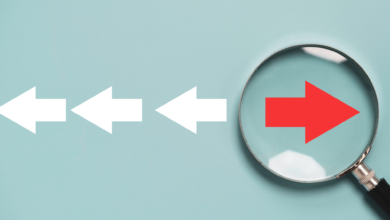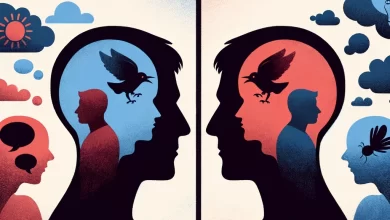One-Sided Relationship Signs & How to Cope – Mindsterk

Did you know that 69% of people have experienced a one-sided relationship at some point in their lives? It’s a staggering statistic that highlights the prevalence of imbalanced relationships, where one person invests more time, effort, and energy than the other.
A one-sided relationship can be emotionally draining and detrimental to your well-being. It leaves you feeling unfulfilled, alone, and undervalued. But how do you recognize the signs of a one-sided relationship? And more importantly, how can you cope with it? Explore the red flags, causes, effects, and coping strategies for navigating one-sided relationships effectively.
Key Takeaways:
- One-sided relationships are characterized by an imbalance in effort and energy, where one person invests significantly more than the other.
- Signs of a one-sided relationship include initiating most activities and communication, making major decisions alone, sacrificing your own needs, and feeling unsure of where you stand.
- Causes of one-sided relationships can vary from differences in communication styles to insecurity and past relationship experiences.
- One-sided relationships can have negative effects on your mental and physical well-being, leading to stress, loneliness, and decreased self-esteem.
- Effective coping strategies involve open communication, setting boundaries, seeking professional help, and recognizing when it’s time to prioritize your own well-being by letting go.
Understanding One-Sided Relationships:
In a one-sided relationship, one person puts in more time, and effort, or has more control, creating an imbalance. Various factors, including differing levels of commitment, lack of communication or understanding, and unequal contributions to the relationship can cause this imbalance.
One-sided relationships can manifest in different types of interpersonal relationships, such as romantic partnerships, friendships, and even relationships with parents or co-workers. They are not limited to specific dynamics or contexts, making it crucial to recognize their existence in various areas of life.
Characteristics of One-Sided Relationships
- One person consistently invests more time, energy, or resources into the relationship than the other.
- There is an imbalance in decision-making power, with one person controlling most of the relationship dynamics.
- Communication and understanding are limited, leading to misinterpretations and misunderstandings.
- Contributions to the relationship, such as emotional support, financial stability, or shared responsibilities, are unevenly distributed.
Causes of One-Sided Relationships
Several factors can contribute to the development of one-sided relationships. These include:
- Differing levels of commitment: When one person is more invested in the relationship than the other, it can create an imbalance.
- Lack of communication or understanding: Ineffective communication and a lack of understanding can prevent the reciprocity needed in a balanced relationship.
- Unequal contributions: When one person consistently contributes more to the relationship, it can lead to one-sided dynamics.
These causes can interact and overlap, further exacerbating the one-sidedness of the relationship.
Types of One-Sided Relationships
One-sided relationships can manifest in various ways, including:
- Romantic relationships: One partner may be more emotionally invested or committed compared to the other.
- Friendships: One friend may consistently give more support, while the other takes on a more passive role.
- Parent-child relationships: A parent may dominate decision-making and control, leaving the child feeling powerless.
- Work relationships: Imbalances can occur in professional relationships, such as one person consistently taking credit for shared work or overpowering others’ opinions.
Recognizing the different types of one-sided relationships can help individuals identify the imbalances and understand the specific challenges they face.
Understanding the characteristics, causes, and types of one-sided relationships is essential in navigating and addressing these imbalances in various relational contexts.
Signs of a One-Sided Relationship:
In a one-sided relationship, there are several indicators that can help you identify the imbalance and red flags. These signs highlight the lack of reciprocity and effort from the other person in the relationship. Being aware of these signs can empower you to make informed decisions about the future of the relationship. Here are some key signs to watch out for:
- Initiating most activities and communication: You find yourself being the one who consistently plans outings, initiates conversations, and takes the lead in maintaining the relationship.
- Making major decisions on your own: Significant decisions, such as those related to finances, career, or future plans, are primarily made by you without much input or involvement from the other person.
- Constantly apologizing: You often find yourself apologizing for things that aren’t your fault, taking blame for misunderstandings, and feeling the need to make amends even when it’s not necessary.
- Sacrificing your own needs: You consistently put the other person’s needs and desires above your own, often neglecting your own well-being and happiness in the process.
- Feeling unsure of where you stand: There is a lack of clarity and consistency in the relationship, causing you to question where you stand and what the other person’s intentions and feelings are.
- Experiencing poor communication: Communication is one-sided, with the other person being elusive, dismissive, or uninterested in engaging in open and honest dialogue.
- Imbalanced financial contributions: You bear a disproportionate share of financial responsibilities, contributing more money and resources to the relationship compared to the other person.
- Making excuses for the other person: You find yourself constantly rationalizing and justifying the other person’s actions or lack thereof, making excuses for their behaviour instead of facing the reality of the relationship.
Recognizing and Addressing One-Sided Relationships
These signs of a one-sided relationship can be unsettling and emotionally draining. It’s important to pay attention to these indicators and assess whether the relationship is healthy and fulfilling for both parties. Recognizing these red flags can help you make informed decisions and take steps towards finding a balanced and mutually satisfying relationship.
| Signs of a One-Sided Relationship | Red Flags of a One-Sided Relationship | Indicators of a One-Sided Relationship |
|---|---|---|
| Initiating most activities and communication | Making major decisions on your own | Constantly apologizing |
| Sacrificing your own needs | Feeling unsure of where you stand | Experiencing poor communication |
| Imbalanced financial contributions | Making excuses for the other person |
Identifying these signs early on can help you address the imbalances in the relationship and work towards establishing a healthier dynamic. However, it’s important to remember that every relationship is unique, and these signs should be considered in combination with other factors. Trust your instincts and remember that you deserve a relationship where your efforts and needs are valued and reciprocated.

Causes of One-Sided Relationships:
One-sided relationships can occur due to various causes, stemming from differences in communication styles, personal insecurities, past relationship experiences, or a lack of relationship skills or training. These factors, along with others such as fear of losing the relationship, imbalanced expectations, mental health conditions, attachment styles, and intentional actions to burden one partner, can contribute to the development of a one-sided relationship.
Communication styles play a significant role in relationship dynamics. When individuals have different communication styles, such as one partner being more open and expressive while the other is reserved, it can create an imbalance in how information is shared, leading to a one-sided dynamic.
Insecurity can also fuel one-sided relationships. If one person in the relationship is plagued by feelings of inadequacy or low self-esteem, they may put in excessive effort to seek validation or avoid conflict, while the other person may exploit this power dynamic.
Past relationship experiences can influence the development of one-sided relationships. For example, if someone has experienced previous relationships where they were taken advantage of or faced emotional abuse, they may unconsciously repeat these patterns in subsequent relationships, resulting in a one-sided dynamic.
A lack of relationship skills or training can contribute to one-sided relationships. If individuals have not developed the necessary skills to establish and maintain healthy boundaries, communicate effectively, or navigate conflicts, it can leave one partner carrying the majority of the emotional labour and decision-making.
Fear of losing the relationship is another common cause. One person may believe that acting in a one-sided manner will prevent the other person from leaving or seeking attention elsewhere, leading to an imbalanced dynamic.
Imbalanced expectations can also contribute to one-sided relationships. If one person has unreasonable or unrealistic expectations of what their partner should provide or contribute to the relationship, it can result in an unfair distribution of effort and resources.
Mental health conditions can impact relationship dynamics, leading to one-sidedness. Conditions such as codependency, narcissism, or anxiety disorders can influence the way individuals perceive and engage within relationships, often prioritizing their own needs over their partner’s.
Attachment styles, rooted in early childhood experiences, can shape relationships. Insecure attachment styles, such as anxious or avoidant attachments, can contribute to one-sided dynamics, as the individuals involved may struggle with intimacy, trust, and reciprocity.
Finally, intentional actions to burden one partner can play a significant role in creating a one-sided relationship. One person may intentionally shirk responsibilities, avoid taking ownership of their actions, or manipulate their partner into shouldering the majority of the relationship work.
Understanding the underlying causes of one-sided relationships can help individuals recognize and address the imbalances within their relationships. By identifying the contributing factors, individuals can take proactive steps to promote healthier relationship dynamics and mutual respect.
Effects of One-Sided Relationships:
In a one-sided relationship, the consequences can be far-reaching and detrimental to your overall well-being. The imbalance in effort, attention, and emotional investment can have significant effects on various aspects of your life.
Impact on Mental Health
One of the major effects of a one-sided relationship is increased stress. Constantly shouldering the burden of maintaining the relationship, making all the effort, and feeling unreciprocated can lead to heightened levels of stress. This chronic stress can manifest in various mental health issues, including:
- Anxiety: Constant worry and uncertainty about the relationship’s future can trigger anxiety symptoms, such as restlessness, irritability, and difficulty concentrating.
- Depression: Feeling lonely, rejected, and unsupported in a one-sided relationship can contribute to the development or exacerbation of depression. Persistent feelings of sadness, hopelessness, and loss of interest in activities may be present.
The stress and negative emotions involved in a one-sided relationship can also disrupt your sleep patterns, leading to sleep problems and fatigue.
Impact on Physical Health
The effects of a one-sided relationship are not limited to mental health; they can also take a toll on your physical well-being. The chronic stress associated with imbalanced relationships can weaken your immune system, making you more susceptible to illnesses and infections. Moreover, the disrupted sleep caused by the relationship’s stress can weaken your overall immune response, further compromising your physical health.
Impact on Self-Esteem
A one-sided relationship can greatly affect your self-esteem and self-worth. Constantly giving while receiving little in return can lead to feelings of inadequacy and worthlessness. The constant imbalance and lack of validation can make you question your value and contribution, resulting in decreased self-esteem.
Impact on Happiness and Satisfaction
Being in a one-sided relationship can significantly impact your overall happiness and satisfaction with life. The constant imbalance and lack of reciprocity can make you feel unfulfilled and dissatisfied, preventing you from experiencing genuine happiness and contentment.
Understanding the effects of one-sided relationships is essential in recognizing the need for change and taking steps towards a healthier and more balanced relationship dynamic.
Coping Strategies for One-Sided Relationships:
Dealing with a one-sided relationship can be challenging, but there are strategies you can use to cope and navigate through this difficult situation. It starts with an honest assessment of the relationship and determining if it is worth saving. If both parties are willing to work on it, the following coping strategies can be effective:
- Open Communication: Establish open and honest communication with your partner. Express your feelings and concerns, and encourage them to do the same. Constructive dialogue can help address the imbalance and work towards finding a resolution.
- Set Boundaries: Establish clear boundaries and expectations in the relationship. Communicate your needs and ensure they are respected. Boundaries help maintain a sense of fairness and prevent further imbalance.
- Seek Professional Help: Consider seeking the guidance of a professional counsellor or therapist who specializes in relationships. They can provide valuable insights, mediation, and guidance for both individuals to better understand their roles in the relationship.
- Focus on Self-Care: Prioritize your own well-being and self-care. Engage in activities that bring you joy and fulfilment. Take care of your physical and mental health through exercise, meditation, or seeking support from friends and loved ones.
However, it is essential to recognize that you can only control your own behaviour and not change the other person. If the relationship remains toxic and unchanging despite your efforts, it may be necessary to consider letting go and prioritizing your own well-being.
Seeking Support and Advice:
Dealing with a one-sided relationship can be challenging and emotionally draining. It’s important to remember that you don’t have to navigate this situation alone. Seeking support and advice from trusted sources can provide valuable insights, guidance, and a sense of community. Here are a few options to consider:
- Talk to a trusted friend or family member: Reach out to someone you trust and feel comfortable confiding in. Share your concerns and emotions with them, and listen to their perspective on the situation. Sometimes, an outside opinion can shed light on the dynamics of the relationship and offer a fresh perspective.
- Seek professional help: Speaking with a therapist or counsellor who specializes in relationships can be beneficial. They can provide a safe and non-judgmental space for you to express your feelings and help you navigate through the complexities of a one-sided relationship. They can also offer guidance on coping strategies and assist you in making informed decisions about the future of the relationship.
- Explore online support forums or groups: Online communities dedicated to relationship advice and support can offer a sense of solidarity and understanding. Engaging with others who have experienced or are currently going through similar situations can provide validation, helpful insights, and coping strategies. It’s important to remember that these platforms should supplement, not replace, professional help.
Remember that seeking support and advice doesn’t mean you have failed or that the relationship is doomed. It’s a proactive step towards understanding your own emotions, gaining clarity, and making informed decisions about your well-being. By opening up and reaching out for support, you empower yourself to navigate the challenges of a one-sided relationship with strength and resilience.

For more information on navigating difficult relationship dynamics, you can refer to WebMD’s article on unrequited love. This comprehensive resource provides further insights and guidance for those seeking help and support in one-sided relationships.
Knowing When to End a One-Sided Relationship:
Deciding to end a one-sided relationship can be a difficult and emotionally challenging decision. However, there are clear signs that indicate it might be time to move on. Recognizing these signs is crucial for your own well-being and happiness.
A sign that it’s time to end a one-sided relationship is when you have repeatedly attempted to communicate and bring about positive change but with no success. Constantly feeling unheard or dismissed can take a toll on your mental and emotional health.
“When you find yourself constantly trying to make the other person understand your needs and desires, but they consistently disregard and dismiss them, it may be an indication that the relationship is not healthy or sustainable.”
Another strong indication that it’s time to end a one-sided relationship is a growing feeling of resentment. When the majority of the effort, compromises, and sacrifices are made solely by you, it can create a sense of imbalance and eventually lead to resentment in the long run.
Emotional or physical abuse is an extremely important sign that a one-sided relationship must come to an end. Your safety should always be a top priority, and any form of abuse should never be tolerated.
A lack of fulfilment and satisfaction in the relationship may also signal that it’s time to move on. If you constantly find yourself feeling unappreciated, unloved, or unsupported, it may be an indication that the relationship is not meeting your needs or bringing you genuine happiness.
Steps to End a One-Sided Relationship and Prioritize Your Well-Being:
When you have recognized these signs, it is essential to take action and prioritize your own well-being. Here are some important steps to consider when ending a one-sided relationship:
- Set a deadline for yourself to make a decision. Give yourself a specific timeframe to reflect on the relationship and assess if changes are possible.
- Initiate honest conversations with your partner about your feelings and concerns. Communicate your needs and expectations clearly, and listen to their perspective as well.
- Seek support from trusted friends, family, or professionals like therapists who can provide guidance and objective advice during this difficult time.
- Take care of yourself physically and emotionally. Focus on self-care activities, engage in hobbies that bring you joy, and surround yourself with positive influences.
Remember, while ending a one-sided relationship can be challenging, it is crucial to prioritize your own happiness and well-being. By recognizing the signs, taking the necessary steps, and seeking support, you can move towards healthier and more fulfilling relationships in the future.
Conclusion:
In conclusion, one-sided relationships can take a toll on your emotional well-being and overall happiness. It is crucial to recognize the signs and evaluate the causes and effects of such relationships. While efforts can be made to improve and cope with a one-sided relationship, it is essential to prioritize your own mental health and happiness.
Seeking support from trusted friends, family members, or professionals can provide insights and guidance in navigating these challenging situations. It is also important to set and communicate your boundaries to ensure that your needs are respected. Ultimately, knowing when it’s time to let go of a toxic relationship is a crucial step towards finding a balanced and mutually fulfilling partnership.
For more information on navigating difficult relationships, you can refer to this study by experts in the field. Remember that you deserve to be in a relationship where your efforts are reciprocated and your happiness is prioritized.






